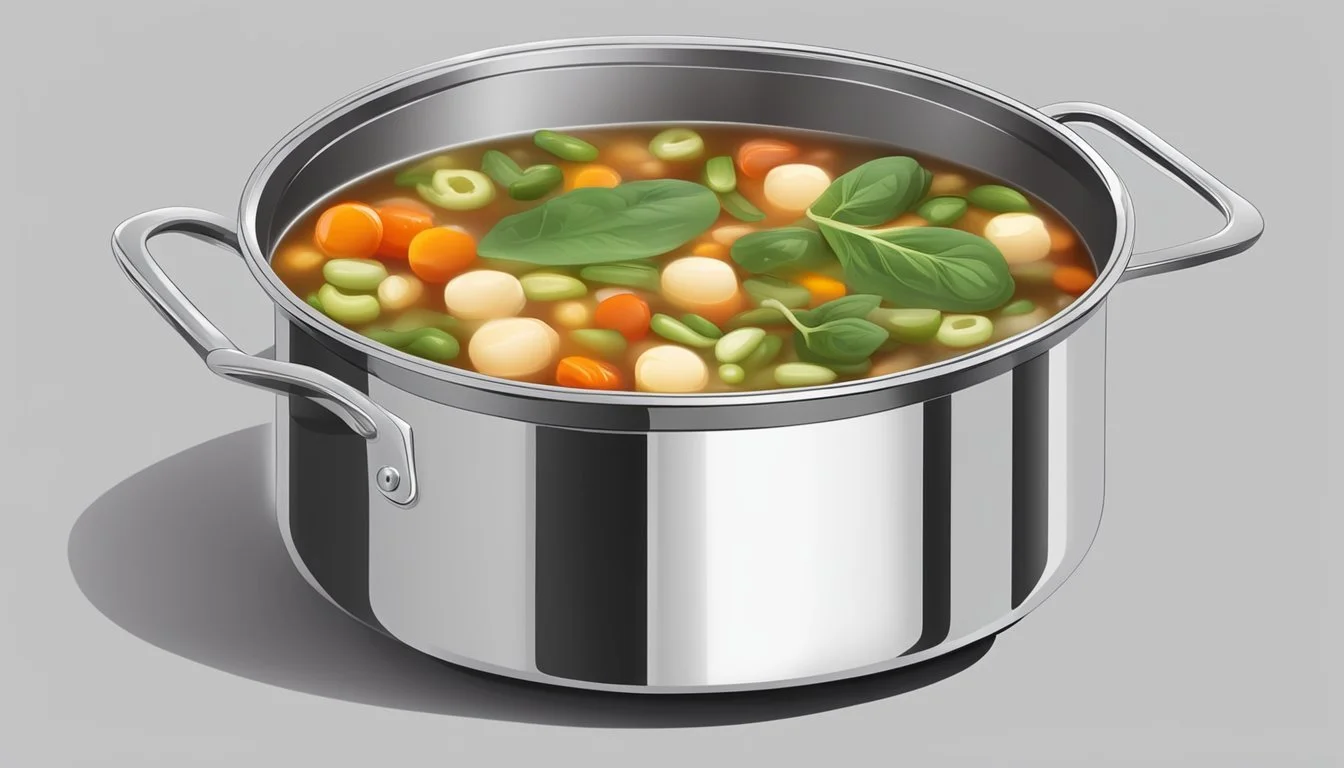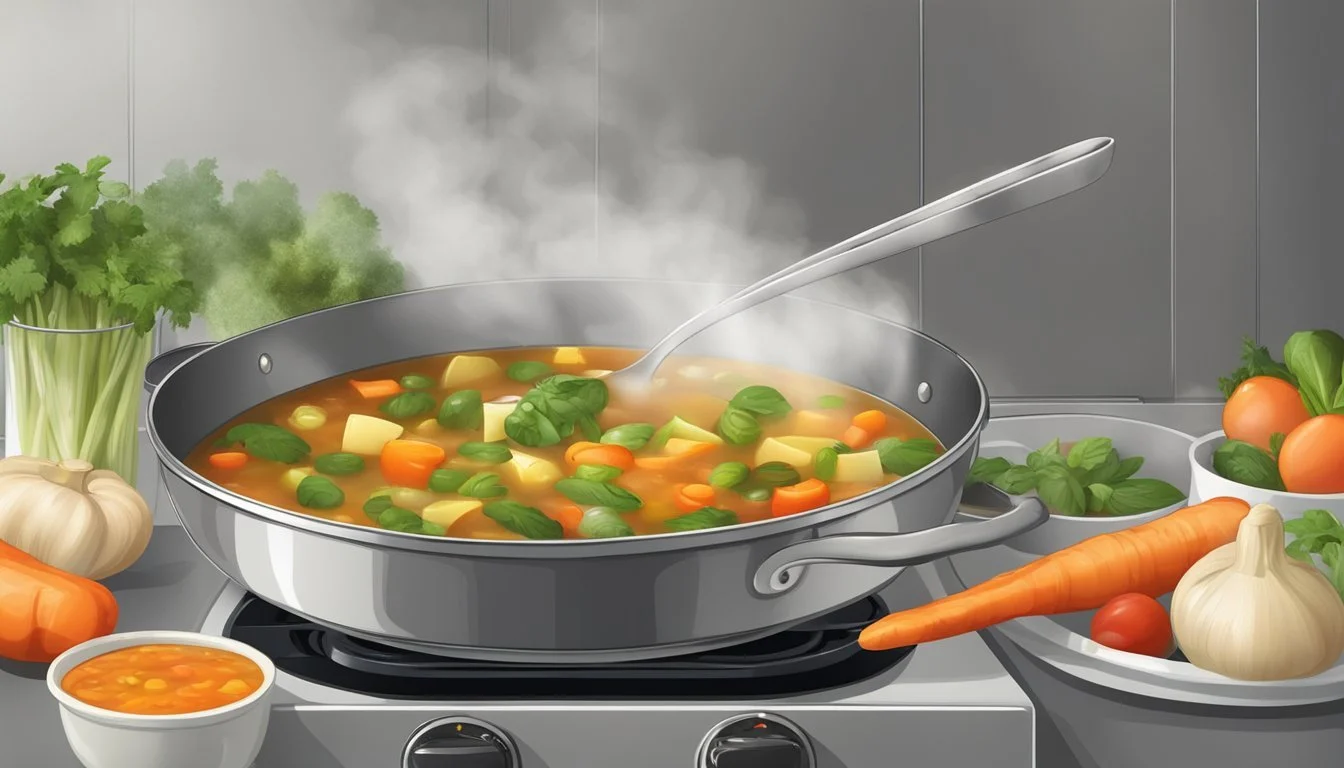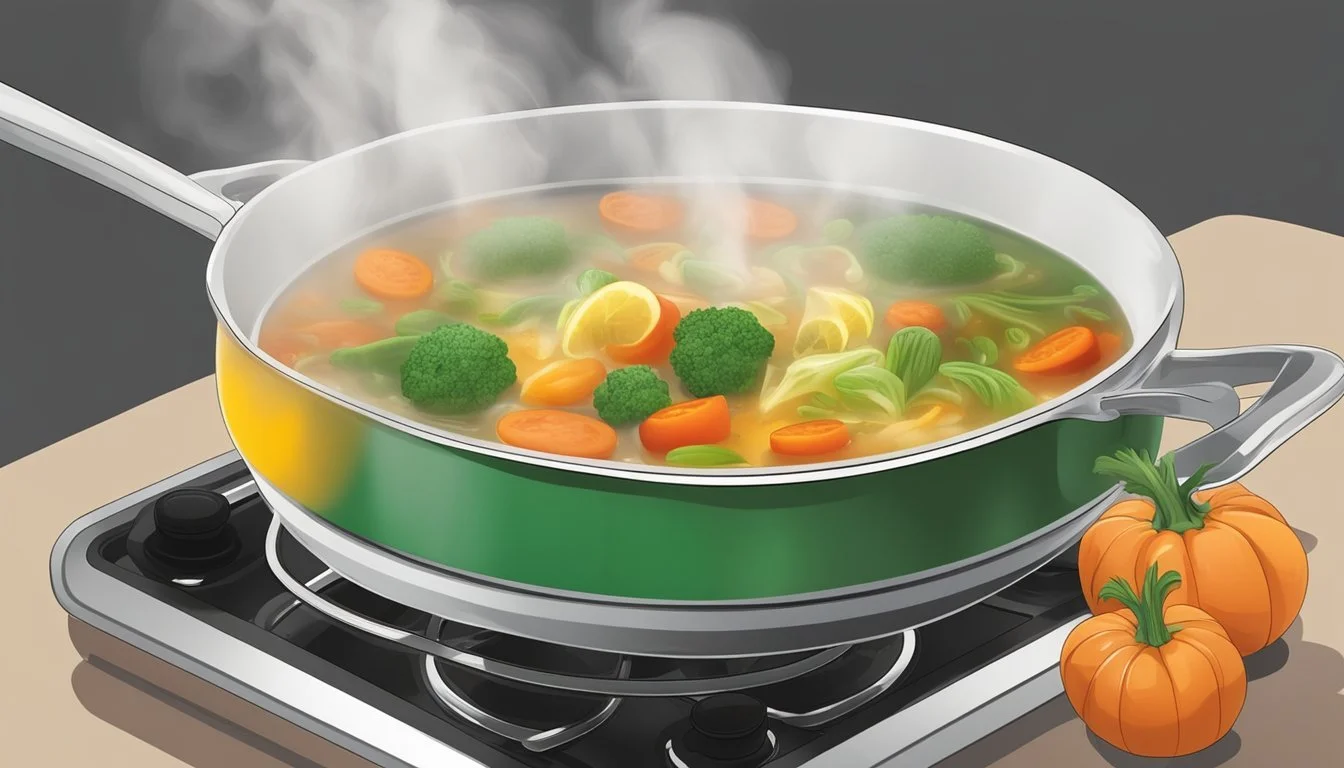Best Way to Reheat Minestrone Soup
Keeping Your Veggies Crisp
When reheating minestrone soup, the goal is to restore its warm comfort without compromising the texture of its abundant vegetables. Minestrone's appeal lies in its variety of ingredients and the delicate balance of flavors, which can be overshadowed by overcooked vegetables (how long do cooked vegetables last?) becoming soggy. Ensuring the vegetables retain their integrity while bringing the soup back to the desired temperature requires a gentle touch and the right technique.
The key to reheating minestrone effectively is in understanding the components that make up the soup. Minestrone typically combines a rich tomato broth with a medley of vegetables, beans, and pasta. Each ingredient has a different cooking time and tolerance to heat, which means that reheating the soup should respect these differences to prevent any one element from becoming too soft or losing its texture.
To avoid soggy vegetables, one should pay attention to the reheating method and duration. Gentle reheating on the stovetop, preferably in stages, allows for more control over the temperature, and can prevent the soup from reaching a boil, which would further soften the vegetables. An even heat distribution and the avoidance of prolonged cooking are crucial to preserving the soup's hearty consistency and ensuring that each spoonful is as enjoyable as when it was first prepared.
Selecting the Right Ingredients
The quality of a minestrone soup hinges on the selection of its ingredients. Each component contributes to the flavor, texture, and nutritional value of the dish, thereby necessitating a careful choice to maintain a balance between taste and health.
Choosing the Best Vegetables
Fresh, seasonal vegetables are the cornerstone of a delectable minestrone. Carrots, celery (how long does celery last?), and onions form the classic base, known as mirepoix, lending a subtle sweetness and aromatics. Green beans and zucchini should be firm and vibrant, as they add crunch and color. For tomatoes, opt for ripe, juicy ones or high-quality canned tomatoes if off-season, to ensure richness and depth.
Opting for the Right Beans
Beans are a source of protein and fiber, making them integral to minestrone. Kidney beans and cannellini beans are most commonly used. They should be well-rinsed if canned to remove excess sodium. For a firmer texture, consider adding the beans toward the end of reheating to avoid over-softening.
Incorporating Proteins for a Hearty Soup
While beans offer plant-based protein, the addition of lean meats or other proteins can transform minestrone into a heartier meal. If one opts for meat, choose cuts that are low in fat and rich in flavor. Alternatively, consider tofu or tempeh for a vegetarian protein boost that maintains the integrity of the vegetables.
Selecting Herbs and Spices for Flavor
The herbs and spices chosen for a minestrone soup bring the classic Italian essence to the forefront. Basil, oregano, and thyme should be fresh or dried of high quality. Garlic, salt, and black pepper are used for foundational flavoring, while a drizzle of good quality olive oil just before serving can elevate the taste.
Cooking Techniques for Minestrone Soup
The mastery of cooking techniques ensures the minestrone soup retains its robust flavors and prevents vegetables from becoming soggy. Key steps include properly sautéing vegetables for a flavorful base, simmering the broth to marry the ingredients, and adding pasta or rice at the optimal time to maintain texture.
Properly Sautéing Vegetables
When cooking minestrone, it begins with sautéing onions, celery, and carrots in oil over medium heat. This process, known as soffritto, creates a flavorful base that enhances the soup. One should sauté the vegetables until they are just softened, which typically takes 3-4 minutes, to prevent them from becoming too soft later on. Adding garlic toward the end of the sautéing process allows it to become golden without burning.
Simmering for the Best Flavor
After the vegetables are sautéed, the addition of diced tomatoes, tomato sauce, and vegetable or chicken broth is crucial. Bringing the soup to a boil and then reducing it to a simmer allows the flavors to meld. The soup should simmer uncovered or partially covered for at least 10 minutes but can go longer for deeper flavor development. Salt, pepper, and other seasonings like Italian spices can be adjusted to taste during this stage.
Incorporating Pasta and Rice
Minestrone often includes ditalini pasta or rice, which should be added when the soup is simmering to avoid overcooking. If pasta is cooked separately and then added, it should be al dente as it will continue to soften in the hot broth. When reheating the soup, cooked rice or pasta may absorb liquid, so extra broth might be needed to adjust consistency. Spinach and other delicate vegetables, like zucchini or green beans, can be added toward the end of the simmering process, and Parmesan cheese is often used as a garnish for added flavor.
Storing Minestrone Soup
Proper storage of minestrone soup ensures its flavors are preserved and the vegetables remain as fresh as possible. Minestrone soup can be stored in the refrigerator for short-term enjoyment or in the freezer for extended conservation, but the method and container used are crucial for maintaining quality.
Cooling and Storing in the Refrigerator
Before placing minestrone soup into the refrigerator, one should cool it down to room temperature. An effective method to expedite cooling is placing the pot of soup in an ice-water bath and stirring occasionally. Once cooled, the soup should be transferred to an airtight container to prevent absorbing flavors from other foods. It can be safely stored in the fridge for 3-4 days.
Freezing for Long-Term Storage
For freezing, divide the soup into manageable portions, as this allows for easy reheating later. Use freezer-safe airtight containers or heavy-duty freezer bags, leaving some space at the top as the soup will expand when frozen. Label containers with the date, and store them in the freezer where they can last for 2-3 months.
Best Practices for Airtight Containers
Choosing the right container not only prevents spills but also helps maintain the quality of the soup. Containers should be made of either glass or BPA-free plastic that's conducive to the temperature changes between the fridge, room temperature, and freezer. Airtight seals are essential to keep the soup fresh, and prevent freezer burn when storing leftovers in the freezer.
Reheating Minestrone Soup
Whether one is reheating a vegetarian classic or a hearty vegan minestrone, the key to maintaining the integrity of the vegetables is gentle heat and timing. Here's how to warm up your soup while keeping those vegetables from turning soggy.
Preventing Soggy Vegetables
To prevent vegetables in minestrone soup from becoming soggy, one should avoid overcooking them during the initial preparation and reheating process. If possible, when initially cooking the soup, slightly undercook the vegetables; they will reach the perfect tenderness when reheated. Reheat the soup just until it's hot, which minimizes the time the vegetables are subjected to heat.
Reheating on the Stovetop
Reheating minestrone on the stovetop is best done in a Dutch oven or a heavy-bottomed pot. Warm the soup over medium heat, stirring occasionally. Start checking the temperature after five minutes to avoid overheating. Once the soup reaches a simmer, reduce the heat and let it warm up for a few more minutes, ensuring the vegetables retain their texture.
Steps for Stovetop Reheating:
Place soup in a Dutch oven or pot.
Heat over medium setting.
Stir occasionally to distribute heat.
Once simmering, reduce to low heat.
Check frequently to avoid overcooking.
Using a Microwave or Slow Cooker
When using a microwave, reheat the soup in intervals of 30 seconds, stirring in between to distribute the heat evenly. This method works best with smaller portions and ensures that the vegetables are less likely to become overcooked.
For those preferring a slow cooker, set it to the 'Warm' setting if available. Transfer the soup into the slow cooker and allow it to heat gradually. This may take up to an hour, depending on the quantity of soup, but is a gentle method that safeguards the soup's texture and flavors.
Accompaniments and Variations
When enjoying minestrone soup, the accompaniments and variations can enhance the meal experience and cater to individual dietary preferences. This section will guide you through pairing options as well as suggestions for those with dietary restrictions, and will explore creative ways to vary the soup's flavor profile.
Suggested Pairings with Bread and Salad
Bread: A slice of crusty bread or a grilled cheese sandwich complements the hearty nature of minestrone soup. The crunchy texture of the bread contrasts with the soft vegetables.
Salad: A fresh green salad dressed in a vinaigrette adds a crisp and refreshing side that balances the richness of the soup.
Alterations for Dietary Restrictions
Gluten-Free: To accommodate gluten sensitivities, one can serve gluten-free bread or choose to thicken the soup with gluten-free flour or pureed beans instead of traditional pasta.
Vegan/Vegetarian: For those following a vegan or vegetarian diet, use vegetable broth instead of chicken broth and ensure any added proteins, such as beans, are plant-based. Skip the parmesan cheese or offer a vegan alternative.
Creative Additions and Flavor Variations
Protein: Adding chicken, beef, or sausage can give a protein boost to the soup for those who prefer a meaty flavor.
Cheese: Stirring in parmesan cheese can enhance the soup's savory taste.
Spices: Experimenting with spices such as rosemary, thyme, or a pinch of red pepper flakes can tailor the soup to personal flavor preferences.
Presentation and Serving Tips
When serving Minestrone soup, presentation is key to enhancing both its appeal and the dining experience. It's an Italian soup that embraces the wholesomeness of a home-cooked meal, making it perfect for gatherings with the whole family. To ensure each serving maintains its integrity and the vegetables stay crisp, consider the following tips:
Reheating: If the Minestrone has been refrigerated, reheat it gently on the stove. Warm the soup on a low to medium heat, stirring occasionally to prevent the vegetables from becoming soggy.
Portion Control: Serve the soup hot and in moderate portions to ensure it doesn't cool too quickly, which often happens with larger servings.
Accompaniments:
A slice of crusty bread, lightly toasted, makes a classical pairing with this hearty soup.
A grating of fresh Parmesan cheese on top adds an authentic Italian touch.
Preparation:
Prep Time: Taking the time to properly chop and prepare the ingredients before starting the soup recipe prevents rushing, which can affect the quality and presentation of the soup.
Cook Time: Cook vegetables until just tender to avoid overcooking in the reheating process.
Total Time: Factor in prep and cook time to avoid serving the soup before its flavors have fully developed.
Garnishing:
Finish each bowl with a drizzle of high-quality olive oil and a sprinkle of fresh herbs for a visually appealing and flavorful garnish.
Adding the garnishes at the last moment ensures their freshness and adds a pop of color.
Presentation and serving are as crucial as the recipe itself. Adhering to these tips can turn the simple act of serving Minestrone soup into an experience that delights all the senses.
Nutritional Information
Minestrone soup, a hearty and healthy Italian staple, is typically abundant in nutrients while remaining relatively low in calories. This soup integrates a variety of vegetables, beans, and sometimes pasta or rice, providing a well-rounded meal.
Calories: The caloric content of minestrone soup can vary, but it generally contains about 90 to 150 calories per 1-cup serving. The addition of pasta, rice, or potatoes can increase the calorie count, so portion size is key for those monitoring their intake.
Nutrition: Minestrone is praised for its nutritional profile, which includes an array of vitamins and minerals from its vegetable content. Foods like tomatoes, carrots, and spinach add vitamins A and C, potassium, and iron to the diet.
Healthy Attributes: With its emphasis on vegetables and beans, minestrone soup is high in dietary fiber. Fiber aids in digestion and can help to control blood sugar levels.
Protein: The addition of beans, such as kidney beans or cannellini beans, not only adds texture but also serves as a good source of plant-based protein. Protein is crucial for muscle repair and immune function.
Fat Content: Traditionally low in fat, especially saturated fat, minestrone soup is often made with a base of heart-healthy olive oil.
In summary, minestrone soup offers a nutritionally dense option that can fit into various dietary needs. It's a food that provides sustenance and numerous health benefits, particularly when careful attention is paid to the quality and quantity of ingredients used.
FAQs and Common Concerns
Q: What's the best method to reheat minestrone soup?
A: They should reheat the soup on the stovetop over medium heat. To avoid overcooking, they can gently warm the soup until it reaches the desired temperature.
Q: How can they prevent vegetables from becoming soggy?
A: They should avoid simmering the soup for too long. If they have the option, they can set aside softer vegetables like zucchini and kale and add them when reheating.
Q: Can they reheat minestrone with meat?
A: Yes, minestrone with meat, like chicken, reheats well. They should ensure that the meat's internal temperature reaches 165°F for safety.
Q: Is it okay to sauté onions before adding them to the reheated soup?
A: Yes, sautéing onions before adding them can enhance the flavor. They should sauté until translucent and then add them to the reheated soup.
Q: What about reheating with fresh vegetables?
A: If they're adding fresh vegetables, they should consider the cooking time for each and add them accordingly to avoid sogginess.
Q: Can they add more ingredients during reheating?
A: Certainly, adding ingredients such as peas or diced tomatoes can freshen up the soup. They should be mindful of the additional ingredients' cooking times.
Q: How should they deal with pasta in the minestrone?
A: Pasta may absorb liquid and become mushy. They can reheat the soup without the pasta and add freshly cooked pasta just before serving to maintain its texture.
Q: Are there variations to reheating if the soup is frozen?
A: If the soup is frozen, they should thaw it in the refrigerator overnight and then reheat it on the stove, following the same precautions to avoid overcooking the vegetables.
Conclusion
When reheating minestrone soup, the key is to maintain its hearty Italian essence and avoid overcooking the vegetables. To prevent the beans and vegetables from becoming soggy, gently warming the soup on the stove over low heat is recommended. If one opts for the microwave, stirring it occasionally helps to distribute heat evenly.
One should remember that minestrone, an Italian classic, is beloved by the whole family for its rich flavor and nutritious ingredients. Preserving the integrity of these ingredients during reheating is crucial.
Lastly, for those in a rush, separating the beans and vegetables from the liquid and warming them briefly before combining everything again can save time while maintaining texture. This method ensures the vegetables stay vibrant and the flavors remain robust, as expected of a well-prepared minestrone.










